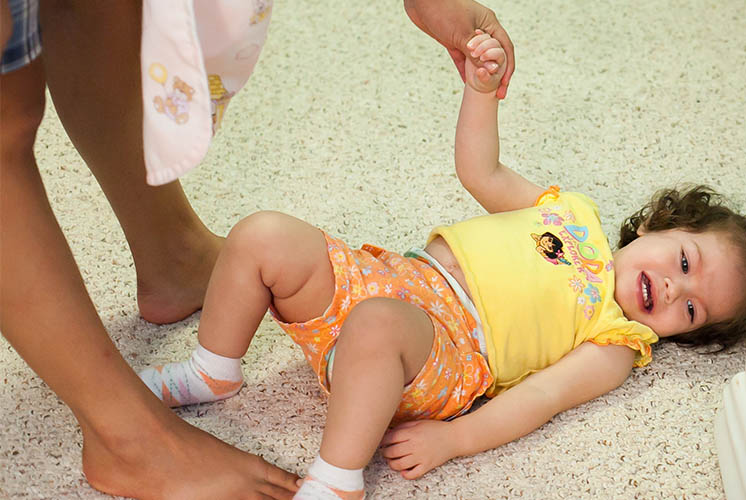Respect is the teacher's process of observing children's actions and assuming they act in pursuit of their interests and questions about the world. Respect assumes that even very young infants have goals and try different strategies to meet their goals or figure out how things around them work.1
Respectful observation reflects a belief that young children's behaviors have purpose and meaning and are worth attention. Education staff who believe young children have goals and intentions ask themselves very important questions:
- Why does this child do what he does?
- What is he trying to communicate or accomplish?
- How should I respond to support this child?
Observation becomes a tool to seek answers to these questions. It provides opportunities to take a moment to determine a child's goal or intention before responding. Observing from a respectful point of view helps staff make important discoveries about children, such as what they are like as individuals, how they respond to other children and adults, what tasks are easy or hard for them, and how they convey wants and needs.2 These discoveries allow staff to be responsive to each child's interests and needs.
 Respectful observation and curiosity about what motivates children become particularly important when their behaviors are challenging to understand and manage. Infants' and toddlers' language skills are just developing, so their primary mode of communication is behavior. Even when they begin using words or sign language, their vocabulary for expressing themselves is still limited. Although some children's behaviors, such as physical aggression, biting, and tantrums, are troubling for both children and adults, these behaviors have meaning. For example, there are many reasons why a young child bites. She may be teething. She may want a toy that another child has. She may be hungry, tired, or even excited and happy. She may just want to know what an arm tastes or feels like in her mouth, and then become fascinated by the "cause-and-effect" reaction that follows.
Respectful observation and curiosity about what motivates children become particularly important when their behaviors are challenging to understand and manage. Infants' and toddlers' language skills are just developing, so their primary mode of communication is behavior. Even when they begin using words or sign language, their vocabulary for expressing themselves is still limited. Although some children's behaviors, such as physical aggression, biting, and tantrums, are troubling for both children and adults, these behaviors have meaning. For example, there are many reasons why a young child bites. She may be teething. She may want a toy that another child has. She may be hungry, tired, or even excited and happy. She may just want to know what an arm tastes or feels like in her mouth, and then become fascinated by the "cause-and-effect" reaction that follows.
Structured observation of the behavior—including what happens before and after it occurs, what time of day it occurs, and who else is involved—provides clues about the child's possible intentions and needs. Conversations with the child's family provide additional information. A pattern of behavior emerges. Adults then match their responses to the child's message (e.g., provide teething toys, make sure there are duplicates of toys, stay physically close to the child in situations that lead to biting, change the schedule for eating and napping).3
The observation approach described earlier is called the "responsive process."4 This approach has three steps and may be used by education staff as well as family members:
- Watch
- Observe the child.
- Note what is happening, what causes the behavior, and what happens after the behavior occurs.
- Ask
- What does the behavior mean to the child? Family? Education staff? Others?
- Adapt
- Decide what causes the child's behavior and identify possible responses.
- Try out one of the responses.
- Watch the child's reactions to see if a different response is needed.
1Sandra H. Petersen, and Donna Wittmer, Endless Opportunities for Infant and Toddler Curriculum: A Relationship-Based Approach, Upper Saddle River, NJ: Pearson Education (2009), 92.
2Margo L. Dichtelmiller, and Laura Ensler, "Infant/Toddler Assessment: One Program’s Experience," Spotlight on Young Children and Assessment (Washington, DC: National Association for the Education of Young Children, 2004), 18; Petersen and Wittmer, Endless Opportunities, 94–95.
3Digging Deeper: Looking Beyond Behavior to Discover Meaning (Washington, DC: U.S. Department of Health and Human Services, Administration for Children and Families, Office of Head Start, 2006), Lesson 1: Slides 3–5.
4Ibid., Lesson 1: Slide 1; Lesson 3: Slide 1.
Read more:
Resource Type: Article
National Centers: Early Childhood Development, Teaching and Learning
Last Updated: December 3, 2019
